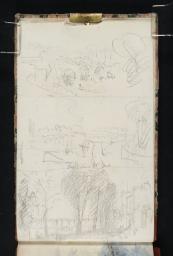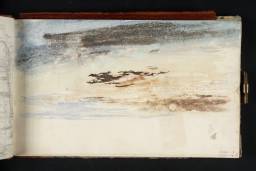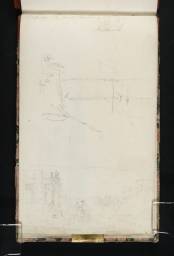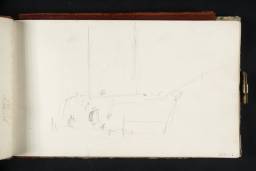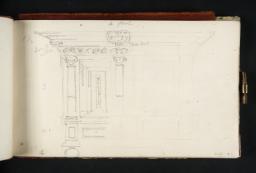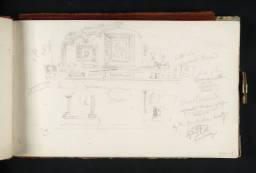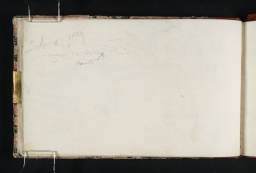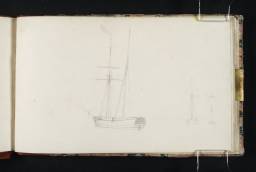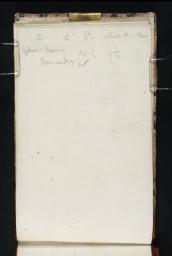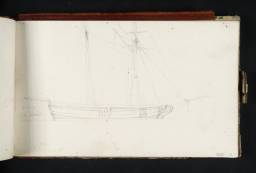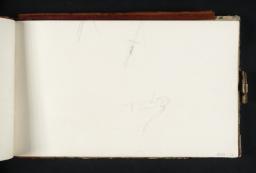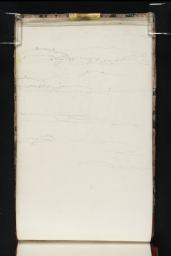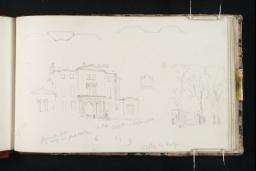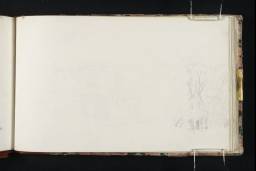Turner Bequest CCXI
Pocket notebook bound in blue marble paper-covered boards, with brown leather spine and pencil holder, and one brass clasp; Turner’s paper label on the spine in inscribed by him in black ink ‘77, Paris, Seine, Dieppe’; the front cover is inscribed in blue ink ‘S73’, blindstamped with the Turner Bequest stamp at the top of the leather spine, and stamped in black ‘CCXI’ at the top right. Executors’ endorsements on folio 1 (Tate D18525; Turner Bequest CCXI 1)
41 leaves of white wove paper watermarked ‘R BERNARD | 1820’
Approximate page size 113 x 189 mm
Made by Richard Bernard at Eyehorne Mill or Park Mill, Hillingbourne, Kent
The wrapper, now lost, was endorsed by John Ruskin, ‘292. Highly interesting for showing as it is. Containing studies for, I believe, his own house and furniture. Two leaves cut out.’
41 leaves of white wove paper watermarked ‘R BERNARD | 1820’
Approximate page size 113 x 189 mm
Made by Richard Bernard at Eyehorne Mill or Park Mill, Hillingbourne, Kent
The wrapper, now lost, was endorsed by John Ruskin, ‘292. Highly interesting for showing as it is. Containing studies for, I believe, his own house and furniture. Two leaves cut out.’
Accepted by the nation as part of the Turner Bequest 1856
Exhibition history
References
This is the smaller of the two sketchbooks that Turner used on his visit in the autumn of 1821 to Northern France (see also Dieppe, Rouen and Paris sketchbook 1821; Tate D24500–D24565; D41261; Turner Bequest CCLVIII complete sketchbook). Turner labelled it the Paris Seine, Dieppe book, but these three places are not particularly prominent in this pocket notebook which was used for pictorial notes on various occasions from the second half of 1821 and perhaps into early 1822. Dating the sketchbook has been made possible owing to the records of financial accounts including costs of building works at his house and gallery at Queen Anne Street, completed by the spring of 1822, on the inside front cover (Tate D40976), and a list of watercolours that Turner painted for Walter Fawkes including many datable to 1821 on another page (folio 10; Tate D18540; Turner Bequest CCXI 10). Ian Warrell has further noted two inscribed dates: ‘Saturday 21’ on the inside front cover, and ‘20 July 182’ on folio 1 (Tate D18525; Turner Bequest CCXI 1), which taken together suggest that the sketchbook was used in 1821 (the year in which Saturday fell on 21 July).1
Sketches of Paris and Dieppe, and studies of people and their regional costumes create a cross-over between the current sketchbook and the Dieppe, Rouen and Paris sketchbook. Particularly significant, however, is the similarity between a sketch of a boat on the Seine at Rouen in the larger sketchbook (Tate D24528; Turner CCLVIII 15) and a sketch of the same boat on a detached and bisected page from the present book (Tate D25519; Turner Bequest CCLXIII (a) 4). The similarity of the sketches prove that both sketchbooks were used on the same tour. The two sketches, while both very slight, provided the subject for an oil sketch made around 1827–8 (Tate N03386),2 and a related watercolour and gouache study executed around 1832: Tate D24727 (Turner Bequest CCLIX 162).3
Among the non-French sketches there are studies of an oak chest and a cabinet that was built to contain the ‘Fairfaxiana’ designs produced by Turner for Walter Fawkes, indicating that the book was also used at Farnley Hall. There are several views on the Thames at Richmond and a design for a composition of a landscape at nearby Twickenham. There are also studies of a boat on the Thames at Greenwich which Ian Warrell has likened to studies of the Royal Squadron of boats at Leith Harbour made by Turner on his trip to Edinburgh in August 1822 to record the royal visit: (Tate D18537 and D18539; Turner Bequest CCXI 8a and 9a). If the studies are connected, then either Turner continued to use this sketchbook into 1822, or the sheets originally belonged to the King at Edinburgh sketchbook (Tate D17672–D17718; D40978–D40980; Turner Bequest CCI complete sketchbook) and were rebound here in error.4 The book also contains studies of a country house, two sky studies in watercolour and two studies of a reclining nude, one of which is in watercolour. John Ruskin’s brief comments on the book’s contents on a wrapper, since lost, were transcribed by Finberg (see the preliminary notes above).5
Technical notes
How to cite
Thomas Ardill, ‘Paris, Seine and Dieppe sketchbook 1821’, sketchbook, March 2013, in David Blayney Brown (ed.), J.M.W. Turner: Sketchbooks, Drawings and Watercolours, Tate Research Publication, August 2014, https://www





